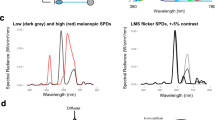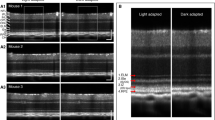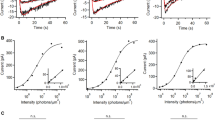Abstract
STILES reported1 that after the eye had been adapted to light of high intensity and long wavelength, its sensitivity to violet test flashes did not recover according to the familiar dark-adaptation curve. Instead the threshold intensity for detecting short-wavelength flashes increased when the adapting field was turned off, and the peak sensitivity of the eye lay at long wavelengths. Yet it was by using very similar conditions that Auerbach and Wald2 isolated a photoreceptor with peak sensitivity in the violet. This contradiction has not been resolved. Transient tritanopia (as we have provisionally termed the loss of sensitivity found by Stiles) has been reported by others3–6 and an electro-physiological counterpart has been described7; but equally there are findings that resemble the contrasting result of Auerbach and Walds8,9. Attempting to resolve this contradiction, we have discovered a second surprising property of transient tritanopia.
This is a preview of subscription content, access via your institution
Access options
Subscribe to this journal
Receive 51 print issues and online access
$199.00 per year
only $3.90 per issue
Buy this article
- Purchase on Springer Link
- Instant access to full article PDF
Prices may be subject to local taxes which are calculated during checkout
Similar content being viewed by others
References
Stiles, W.S., Doc. Ophthal., 3, 138–169 (1949).
Auerbach, E., and Wald, G., Science, 120, 401–405 (1954); Am. J. Ophthal., 39, suppl. 1, 24–40 (1955).
Das, S. R., J. opt. Soc. Am., 54, 541–546 (1964).
Watkins, R. D., Vision Res., 9, 1185–1196 (1969).
Mollon, J. D., and Polden, P. G., Nature, 258, 421–422 (1975).
Wright, W. D., Researches on Normal and Defective Colour Vision (Kimpton, London, 1946).
Gouras, P., J. Physiol. Lond., 199, 533–547 (1968).
Du Croz, J. J., and Rushton, W. A. H., J. Physiol. Lond., 183, 481–496 (1966).
Norren, D. V., and Padmos, P., Vision Res., 14, 677–686 (1974).
Mollon, J. D., and Polden, P. G., J. Physiol. Lond., 254, 66P (1976).
Baker, H. D., Doran, M. D., and Miller, K. E., J. opt. Soc. Am., 49, 1065–1070 (1959).
Cornsweet, T., Am. J. Psychol., 75, 485–491 (1962).
Weale, R. A., Nature, 191, 471–473 (1961).
Brindley, G. S., J. Physiol. Lond., 122, 332–350 (1953).
Author information
Authors and Affiliations
Rights and permissions
About this article
Cite this article
MOLLON, J., POLDEN, P. Absence of transient tritanopia after adaptation to very intense yellow light. Nature 259, 570–572 (1976). https://doi.org/10.1038/259570a0
Received:
Accepted:
Issue Date:
DOI: https://doi.org/10.1038/259570a0
Comments
By submitting a comment you agree to abide by our Terms and Community Guidelines. If you find something abusive or that does not comply with our terms or guidelines please flag it as inappropriate.



